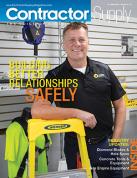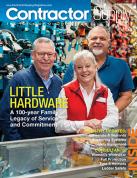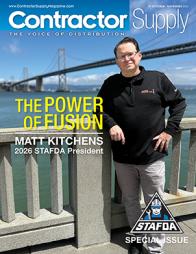Chally: Failure to merge
Why 70 percent of M&A deals don’t achieve expected results.
By Ken Carroll
The reasons that mergers and acquisitions so often fail — from flawed assumptions to insufficient planning, poor execution and cultural conflict — are numerous and well known. However, some wholesaler-distributors consistently do this kind of growth very well. How do they succeed where others fail?
The answer is at once obvious and endlessly challenging. Successful M&A transactions begin by recognizing that people-related decisions are the most difficult variables in almost any transaction, and pose the greatest risks — such as turnover up to 60 percent or lingering cultural conflicts that cripple productivity. They succeed by carefully managing human capital to transform two groups of people into one functioning company.
|
More than any other asset, human capital underlies what a distributor is and does, and the long-term human capital lifecycle animates its evolution and growth. Any M&A event is hugely and lastingly disruptive to this lifecycle. |
Focus on the human capital
More than any other asset, human capital underlies what a distributor is and does, and the long-term human capital lifecycle animates its evolution and growth. Any M&A event is hugely and lastingly disruptive to this lifecycle. And yet, the success of the deal depends on sustaining and directing it. Most transactions aim to generate a return on the investment through synergies, such as:
- Acquiring and expanding customer relationships
- Generating new channels for the combined offerings
- Creating unique new capabilities, products and services
- Gaining operational efficiencies and synergies
What drives all of these is human capital. In the merged sales and marketing teams, in product development, and in the running of the organization, putting the right people in the right places is the key to making synergies happen.
To get the people element right, firms that succeed at growth-by-acquisition tend to apply the same kind of disciplined, data-driven approach to human capital that they use in other areas of M&A activity. In place of financial and operational metrics they use talent analytics — predictive, scientifically proven measures of human performance. Based on detailed competencies, these can accurately predict each person’s ability to perform well in a given role. With these tools in hand, leaders blend art and science to craft a complete people strategy.
Art and science
Like most aspects of business, doing M&A well is part art and part science. Mastering “the art of the deal” takes strategic insight, negotiation, leadership and deep experience. These skills are often personal, subtle ones. They take years to learn and can’t easily be analyzed or quantified.
On the other hand, the “science” of understanding and managing quantitative information is also essential. From due diligence through integration, making sense of the financial, operational and customer data can demand a great deal of work. Those tasks, however challenging, are at least well understood.
What’s missing from this sketch? When a deal doesn’t live up to expectations, you’ll often hear executives explain failure by saying “We didn’t do a good job on the people side,” or “It was difficult to merge the two cultures.” What they really mean is that they didn’t combine the two companies’ human capital as well as they did the financial and organizational assets.
Specifically, they didn’t anticipate disruptions to the human capital lifecycle accurately and manage them aggressively. More often than not, the underlying reason that M&As fail is that leaders understood the art, but not the science, of human capital.
Yes, it really is a science
What these decision-makers don’t realize is that human capital can be measured and analyzed with great rigor and precision. The science of talent analytics has helped drive staffing decisions in the enterprise for years. It’s been particularly effective in high-turnover areas such as customer service and sales, as well as in leadership development at much higher levels of the organization. Today, tools and expertise for managing talent scientifically are widely available at all levels and for companies of any size.
In an M&A situation, talent analytics can help the transition team assess and manage the human capital involved much as they would any other key asset. Doing so helps them deploy the merged companies’ employees efficiently and productively. When the right people feel they’re in the right jobs, they have a fighting chance to create the synergies they’re expected to produce.
The devil you know
The alternative is probably all too familiar. Faced with little objective information available about an unknown workforce, those in charge rely heavily on employees whom they or their managers already know. Even if those people aren’t the best-performing, “the devil you know” is usually better than someone you don’t. In a very collaborative deal, the same thing happens in reverse: the transition team trusts the other company’s opinions about staffing, which may turn out to be just as limited as their own.
Issues of scale often aggravate the problem. In a smaller company, senior leaders often know most of their employees personally. Making decisions informally works just fine — in fact, hands-on, personal management can be a point of pride. But as a company grows, this approach doesn’t make sense anymore. Of all the “growing pains” successful companies face, learning to manage human capital more rationally is often one of the most difficult. The sudden demands of integration simply make the challenge more urgent.
Scientific human capital management has another important benefit in the fluid environment of an acquisition or merger. Where uncertainty and fear can wreak havoc, a focus on objective, unbiased information, placed at the center of a well-publicized plan, can help take some of the emotion out of staffing decisions.
Competencies at the core
So what exactly do talent analytics measure? Predictive, scientifically validated psychometric assessments provide the raw data. What makes it useful is an understanding of core competencies, the skills and behaviors essential to success in a given job.
Step one is to define a competency model that describes at a high level what the merged workforce will look like. Then comes the heavy lifting: expanding detailed competency sets down to the level of individual roles. As the integration goes forward, these become a roadmap for people to understand the part they play in the integration process.
Leaders may expect to simply inherit the best talents from an acquired or merged company, minus a few “poor fits.” In reality, merging roles across two companies takes a detailed analysis of competencies and careful transition of talent into the blended organization. The result of all this analysis is a workforce that’s custom-built for the task at hand — both during the transition and long afterward.
Can culture be managed?
Culture may be both the most critical factor in a merger and the most difficult to pin down. We know that culture is the glue that holds a company together. But even here, talent analytics can offer new perspectives.
A competency-based approach can assess not simply skills or knowledge but the attitudes, interests and motivations that add up to success on the job. Will the merged culture stress close collaboration or independent thinking? Methodical planning and development or rapid implementation followed by iteration? Should you ask for permission first or beg for forgiveness later?
By framing the culture at the level of detailed behavioral competencies, leadership can show people exactly what they need to do not just to survive, but to thrive in the new environment.
A roadmap for M&A success
Every M&A event is a unique, complex process, but the roadmap generally features certain mileposts.
1. Due diligence. Prior to a merger or acquisition, the human capital focus is all on leadership. Using talent analytics in the due diligence process lets decision-makers quantify the potential of senior managers objectively and predictively. And while companies typically only look one level down from the C-suite, talent analytics make it practical and highly insightful to investigate deeper layers of the organization.
2. Black-out period. During the quiet period, a “clean team” expands assessment and analysis of human capital more broadly. When the deal goes live, the transition team will be prepared to make key staffing decisions immediately, based on science, not politics.
3. Initial integration. While the combined company focuses on a short list of immediate “must-do” items, the human capital work expands organization-wide. Redundant positions will generally be found in a variety of support roles, even broadly if consolidation of production and logistics is required. Competency-based measures of the ability to perform provide the data —and a gap analysis provides the means — to map the most capable talent to appropriate roles objectively, consistently and fairly.
This experience can still be highly disruptive and distressing for the people involved. A formal change management program is essential at this stage to help people understand what is happening, what will happen and why to anticipate and address their concerns during the transition and to give them the support they need to remain engaged and successful.
Aligning the workforce with the merged entity’s strategy and tactics is not all about damage control, however, or simply about what’s urgently required to go forward as one. An M&A event can also be an opportunity to address longstanding performance or cultural issues in one company or both. Given the opportunity for an organization-wide “reboot,” leaders should take full advantage of it.
4. Sales force consolidation. Sales organizations are often a special case. Competitors commonly share a customer base, and when sales forces merge, customers may believe their interests are not well served by reducing competition. Careful assignment of account responsibilities will help preserve strong customer relationships and retain the best talent. In the charged atmosphere of a merger, analytics are critical to making these decisions more objective and less political.
Moreover, the competencies that can predict success in sales roles vary tremendously depending on the complexity of the firm’s offerings, where they fit on the spectrum from products to solutions and the customer’s level of experience with them. These circumstances can change fairly rapidly, while sales organizations often fail to change with them. The seismic shifts surrounding an
M&A event make it an ideal time for a sales force transformation that may already be overdue.
5. Long-term commitment. One way that deals often fail is simply through underestimating the effort required. Integration can be a long-term process, particularly when two strong cultures must come together. Changing market conditions or an unexpected competitive response can also make an impact. If the leadership has the patience and commitment to test, measure and refine the integration strategy over time, talent analytics provide the tools.
As time goes on, successful companies develop the skills and inclination to use data-driven human capital management in other contexts beyond M&A events. These include identifying and developing high-potential individuals, senior leadership development and succession planning.
It’s also worth noting that problems can occur not only when M&A activity happens, but when it stops happening. A company that’s growing rapidly though acquisitions may let its people more or less run free. When strategy or the landscape changes and the music stops, so does the growth. This may offer an opportunity to turn inward and focus on optimizing human capital company-wide.
6. Repetition. No distributor gets everything right on the first try. Research has shown that developing a specific, repeatable M&A model over time is a key factor for consistent success. As a company continues to execute and refine the model, the path becomes well established. Employee performance data, business metrics and customer satisfaction all formulate and refine it. The techniques of talent optimization become more familiar, better focused and more effective. Employees at all levels understand the process and know what parts they play in it. And as success breeds success, everyone becomes more informed and engaged.
The art of science
Used well, talent analytics can ensure lower-risk, fact-based staffing decisions. These put the very best resources in place to deliver the synergies envisioned from the deal, and the return on investment expected of it. Like most new tools, they also pose significant challenges.
Analytics generate huge amounts of data that must be manipulated, analyzed and put to work in a complex human environment. This takes advanced scientific and technical expertise and long experience. But making sense of the data also takes a deep and nuanced understanding of how people work within organizations.
Ultimately, the “people side” of an M&A event is about people, not data. Getting it right demands careful planning, thorough analysis and an awareness that applying scientific principles to human experience will always call for a measure of art. CS
 Ken Carroll is CEO of Chally Group Worldwide. Chally’s history of predictive assessment science, coupled with extensive consulting expertise in sales and leadership performance, makes it a leading authority on navigating the challenging course of successful merger and acquisition transactions.
Ken Carroll is CEO of Chally Group Worldwide. Chally’s history of predictive assessment science, coupled with extensive consulting expertise in sales and leadership performance, makes it a leading authority on navigating the challenging course of successful merger and acquisition transactions.
For more information about how Chally’s talent analytic tools can help make those critical human capital decisions, call (800) 254-5995 or visit www.chally.com.
















